| Designation: | K1 |
 |
|---|---|---|
| Manufacturer: | Rotem Company, Technical Research Institute | |
| Product type: | Armoured Vehicles | |
| Name: | Main battle tank |
Following proposals from a number of armoured fighting vehicle manufacturers, in 1980 the South Korean government selected the now General Dynamics Land Systems to design and build two prototypes of a new MBT to meet its own specific requirements.
The first of two prototypes of the XK-1 MBT was completed in 1983, the Automotive Test Rig (ATR). It was shipped to Aberdeen Proving Grounds in November 1983 for automotive performance, endurance and reliability testing. The ATR was a fully payloaded tank fitted with a non-operational turret.
The second prototype, called the Fire-Control Test Rig (FCTR), was rolled out at a ceremony at Selfridge Air National Guard base in December 1983 and shipped to Aberdeen Proving Grounds in February 1984 to begin fire-control tests.
Production of the XK-1 began in South Korea in 1984 and first production vehicles were completed in 1985. The vehicle was subsequently type-classified as the K1 MBT and the tank made its first appearance in September 1987, by which time several battalions had been equipped with it. The first production batch of 210 vehicles was completed in 1987 with the second batch consisting of 325 vehicles.
Many key components of the K1, such as the CDC ballistic computer, MTU diesel engine, ZF transmission and SFIM roof-mounted sight are now being manufactured in-country.
By early 1998, total production of the K1 MBTs and variants amounted to just over 1,000 units with production still under way.
As of early 1999, the K1 MBT and its variants had not been exported. A variant of the vehicle, designated the K1-M, has been designed and manufactured to meet the future Malaysian MBT requirement.
This has a number of modifications to satisfy the Malaysian Army requirement including the installation of an air conditioning system, NBC system, laser warning system and explosive reactive armour as well as a reduction in the combat weight of the vehicle to less than 50 tonnes
As one of its marketing efforts, Hyundai exhibited the K1 MBT, K1 ARV and K1 AVLB at the DSA '96 show in Malaysia in 1996. Following the exhibition Hyundai carried out an operation and mobility performance in front of the Malaysian Army officers at the Malaysian Armour School located on Port Dickson.
The layout of the K1 MBT is conventional, with the driver's compartment at the front, fighting compartment in the centre and engine and transmission at the rear.
Over the frontal arc of the K1 MBT, including the nose, turret front and sides, advanced armour of the Chobham type is fitted, which is manufactured in the US; this provides protection from both kinetic and chemical energy attack.
The driver is seated front left and is provided with a single-piece hatch cover pivoted on the left that lifts upwards to open. This has three integral day periscopes, the centre one of which can be replaced by a passive night driving periscope. The commander is seated on the right of the turret with the gunner below and forward of his position and the loader on the left.
The commander has a French SFIM two-axis independent stabilised panoramic sight which has a magnification of x3 and x10, periscopes for all-round observation and a single-piece hatch cover that opens to the rear. This is manufactured in South Korea by Samsung Electronics Co Ltd, under licence from SFIM.
The gunner's two-axis stabilised day/night sight device incorporates a laser range-finder and thermal imaging system which is similar to that installed in the M1A1 MBT and has magnifications of x1 and x10(day) and x3 and x10 (night). The gunner's articulated auxiliary sight is provided by the Electro-Optical Division of the Kollmorgen Corporation and Opto Mechanik Inc (OMI). This has a magnification of x8.
The latest Texas Instruments Gunner's Primary Tank Thermal Sight incorporates an eye-safe carbon dioxide laser range-finder with final integration and testing taking place in South Korea.
Turret drive and weapon elevation is electrohydraulic with manual controls for emergency use. Stabilisation is provided in both elevation and traverse.
The fire-control system includes a Computing Devices Company digital ballistic computer with a number of sensors including crosswind and allows the tank to engage both stationary and moving targets while it is stationary or moving itself.
Main armament comprises a US-designed 105 mm M68A1 rifled gun which is also fitted on many South Korean M48A5 MBTs and for which ammunition is made in South Korea, including APFSDS. The barrel has a fume extractor, thermal sleeve and a muzzle reference system.
A 7.62 mm M60E2 machine gun is mounted coaxially with the main armament. The loader has a 7.62 mm M60D roof-mounted machine gun while the commander has a 12.7 mm K6 roof-mounted machine gun. Mounted either side of the forward part of the turret is a bank of six electrically operated smoke grenade dischargers.
An unusual feature of the K1 is the hybrid suspension system with improved torsion bars in the centre and hydropneumatic suspension units at each end. This allows the tank to kneel so that the main armament can be depressed to -10°. The remote track adjusting system has two mode settings.
The drive sprocket is at the rear, idler at the front, with six dual rubber-tyred roadwheels, track-return rollers with the upper part of the track being covered by an armoured skirt. For the track, either the replaceable or integral rubber pad can be fitted.
The rear-mounted power pack consists of a German MTU MB 871 Ka-501 1,200 hp diesel coupled to a German ZF LSG 3000 fully automatic transmission with acceleration from 0 to 32 km/h in 9.4 seconds.
Standard equipment includes a passive image intensification periscope for the driver, hydraulic bilge pump, heater, automatic Halon fire detection and suppression system for both crew and engine compartments and a VRC-947K and/or VRC-964K and a VIC-7K for intercom system.
The NBC system consists of an M8A1 alarm system andanM13A1 gas particle filter.
It is understood that early in 1996, Hyundai completed two prototypes of the K1A1 MBT based on the proven mobility and fire-control system of the earlier M1 MBT. These two prototype vehicles successfully passed all severe testing conducted through February 1997. These trials were carried out by the Republic of Korea government under a variety of weather and terrain conditions.
The K1A1 MBT has an increased firepower performance over the earlier K1 MBT owing to the adoption of a Korean Commander's Panoramic Sight (KCPS) which has been locally developed.
This has a greatly improved performance and function compared with the existing Commander's Panoramic Sight (CPS) for the K1. The K1A1 is also armed with the 120 mm M256 smooth bore gun which is also installed in the General Dynamics Land Systems M1A1 and M1A2 Abrams MBTs.
The main characteristics of the K1A1 MBT have been summarised by trie manufacturer as follows:
(1) The significantly enhanced armour penetration power and combat firing range due to the installation of a 120 mm smooth bore gun instead of the 105 mm rifled gun of the earlier K1
(2) Improved performance in the driving and stabilisation of the gun and turret by improving the gun/turret drive system for the 120 mm gun
(3) Enhanced processing speed and capability of the ballistic computer
(4) Enhanced night combat and operation capability by adding a thermal imaging capability to the commander's panoramic sight
(5) Improved sealing capability in fording operations and the turret slewing characteristics during moving by improvement of the race ring (or turret bearing) as well as enhanced survivability for the crew by adoption of the improved fire suppression system including thermal wire sensor for the engine bay
(6) Easier maintainability and lowered maintenance cost by utilising a track with replaceable pads.
It is understood that based upon the capability and experience of research and development for the development of the K1 and K1A1 MBTs, Korea is now developing a new concept MBT taking into account the 21st century battlefield environment.
While no characteristics of this new MBT have been officially disclosed, it is assumed that the following factors have been considered:
(1) Significantly enhanced firepower with the main gun utilising the latest gun technology
(2) Significantly enhanced crew survivability by adoption of special armour utilising new materials and active defence system
(3) Automated and intelligent fire control system and other control systems
(4) Maximised combat efficiency by adoption of vetronics and battlefield management system.
It is understood that ADD, an agency of the Korean government and Hyundai, prime contractor of the M1 and M1A1 MBTs, undertook the concept study and funding for the Future Main Battle Tank (FMBT) for the Korean government.
awarded a contract by Hyundai Precision and Industry Co Ltd to design and build the prototype of an Armoured Vehicle-Launched Bridge (AVLB) system and bridge.
The AVLB will launch a scissors-type bridge similar to the British No 8 tank bridge which is carried and launched over the front of a Chieftain. This bridge has an overall length of 22 m and can span a gap up to 20.5 m depending on the firmness of the bank.
The bridge and its associated launching system was built at Vickers Defence Systems' Newcastle-upon-Tyne facility and shipped to South Korea in 1990 where it was integrated with the chassis, based on the K1 MBT, designed and built by Hyundai Precision and Industry Co Ltd.
Late in 1993, Hyundai awarded Vickers Defence Systems a contract worth £23 million to supply the bridges for the K1 AVLB.
The contract covers the manufacture of eight bridges and 41 launching mechanisms in the UK which will be installed on the K1 AVLB chassis by Hyundai. The total South Korea requirement is for 56 K1 AVLBs and the balance of the bridges and launching mechanisms will be built in South Korea by Hyundai under a technology transfer agreement.
The bridge takes 3 minutes to be launched and 10 minutes to be recovered, with maximum bank height differences being 2.4 m.
The K1 AVLB has a total weight of 49.6 tonnes and in travelling configuration is 12.5 m long, 4.0 m wide and 4.0 m high. The bridge itself weighs 12.9 tonnes and is Class 66 (this means that it can take AFVs to a maximum combat weight of 60 tonnes). It has a crew of two and is armed with a 7.62 mm M60D machine gun.
Hyundai Precision and Industry Co Ltd has developed an ARV based on the chassis of the K1 in co-operation with the German company MaK. In appearance it is similar to the ARV based on the Leopard 1 and Leopard 2 MBT chassis which MaK developed to meet the requirements of the German Army.
Standard equipment includes a front-mounted dozer/stabiliser blade, main winch with a maximum capacity of 35 tonnes (70 tonnes with pulley) and 150 m of cable, with a crane being mounted at the front right side of the hull. When travelling this is stowed alongside the right side of the hull. It can be traversed through 270° and has a maximum lifting weight of 25 tonnes. An auxiliary winch, auxiliary power unit, electric impact wrench and welding equipment are also provided.
In November 1991, Hyundai of South Korea, prime contractor for the K1 family of MBTs, awarded MaK System Gesellschaft mbH a production contract for subsystems for the K1 ARV.
Following extensive trials of a prototype K1 ARV using MaK System Gesellschaft mbH-designed recovery equipment, MaK was awarded a production contract for recovery equipment except for some localised components.
Production of these is undertaken at MaK System Gesellschaft mbH's Kiel facility, with first deliveries completed late in 1993. This vehicle is now in service, with the first order being for 90 vehicles followed by a second order for 59.
The recovery equipment is integrated into the chassis by Hyundai which then delivers the complete vehicle to the South Korean Army. Hyundai is building the remainder of the recovery equipment such as dozer, winch and crane system in South Korea as part of a technology transfer from MaK System Gesellschaft mbH.
TheK1 ARV has a crew of four and weighs 51 tonnes, or 56 tonnes when carrying a spare power pack. It is armed with a 12.7 mm machine gun operated by the vehicle commander.
For trials purposes the K1 MBT has been fitted with a roller type mineclearing system at the front of the hull.
Studies are already under way on a combat mobility version of the K1 which would use a similar hull to that of the K1 ARV previously described but would carry special equipment to undertake the engineer role.
This is the version being proposed to Malaysia and key differences in the specifications are listed in Table 1.
In production. In service only with the South Korean Army.
|
||||||||||||||||||||||||||||||||||||||||||||||
|
|||||||||||||||||||||||||||
|
||||||||||||
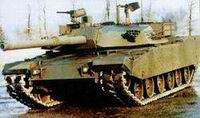 |
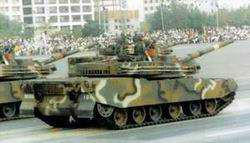 |
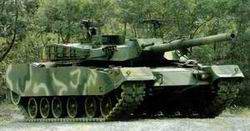 |
 |
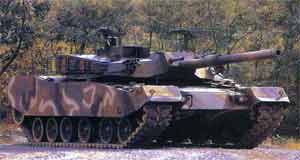 |
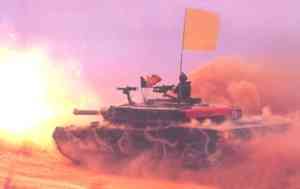 |
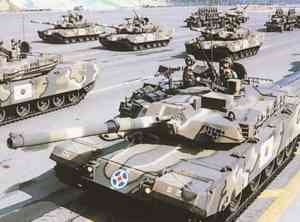 |
 |
 |
 |
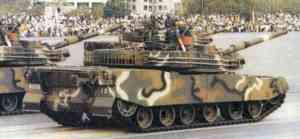 |
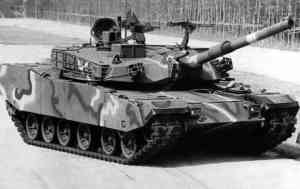 |
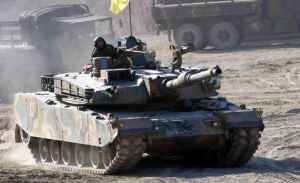 |
 |
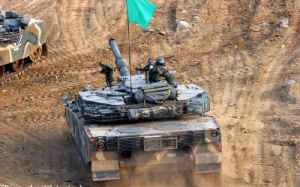 |
 |
 |
